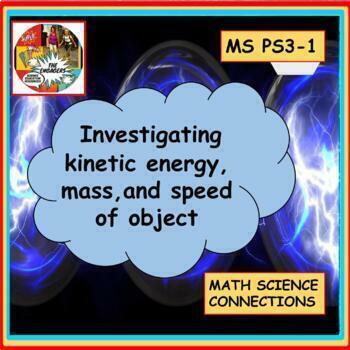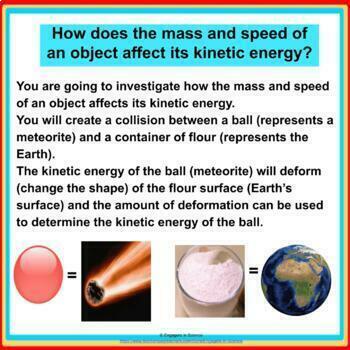Kinetic energy, mass, and speed investigations NGSS MS PS3-1 CER
- Google Drive™ folder

What educators are saying
Also included in
- Do your students need more practice using the claim, evidence, reasoning structure (CER)? These three lessons will give your students the practice they need. These three engaging investigations support the NGSS standards MS PS3-1, MS PS3-2, and MS PS 2-2.In all three investigations, students designPrice $8.00Original Price $9.00Save $1.00
- This bundle includes everything you need to teach an NGSS aligned middle school energy unit. These highly engaging lessons (GOOGLE and PDF versions) align with the philosophy of the NGSS, including a focus on deeper understanding of content as well as application of content, student performance expePrice $20.00Original Price $22.00Save $2.00
Description
These two investigations (GOOGLE and PDF versions) allow students to develop an understanding of the relationship between kinetic energy and mass of an object, and kinetic energy and speed of an object. As students are collecting their own data, it is more understandable compared to being given data to analyze. This activity supports the NGSS standard MS PS3-1
A review (or introduction) of some of the key terms such as mass, kinetic energy, speed, energy transformations, and conservation of energy is given including a short activity where students “discover” the formula for speed.
This is followed by an explanation of what happens to the kinetic energy of a meteorite when it crashes into the Earth forming a crater. In the two investigations students will be creating a collision between a ball (representing a meteorite) and a container of flour (representing the Earth). The kinetic energy of the ball (meteorite) will deform the flour surface (Earth’s surface) and the amount of deformation can be used to determine the kinetic energy of the ball.
Students will be designing and performing their experiment, collecting data, graphing and analyzing the data to see the relationship between mass, speed, and kinetic energy.
They will use the CER (claim, evidence, reasoning) structure to write their conclusion.
Easily obtainable materials are used for these investigations (see list below).
Answers (when appropriate) are given in the detailed teacher notes, and a rubric is included.
The science and engineering practices below are incorporated in this investigation:
Developing and using models.
Planning and carrying out investigations.
Analyzing and interpreting data.
Using mathematics and computational thinking.
Engaging in argument from evidence.
The Cross Cutting Concept is incorporated in this investigation:
Scale, Proportion, and Quantity:
Proportional relationships among different types of quantities provide information about the magnitude of properties and processes.
Included in this resource:
Teacher slides (22 slides)
Detailed teacher notes (9 pages)
Printable student worksheets with activity instructions.(5 pages)
Sample answers including a rubric for the CER conclusion
Suggested materials needed:
Bowl of flour
Ball or play dough
Something to increase the mass such as dried beans or coins
Balance
Ruler
You may also like:
Investigating Potential Energy and Energy Transfer NGSS MS PS3-2 CER
Heat transfer (conduction, convection, radiation) investigations NGSS MS PS3-3
Investigating Newton's First Law of Motion MS PS2-2
Investigations into balanced and unbalanced forces MS PS2-2 CER
Investigating Newton's Third Law of Motion MS PS2-1
Constructing a space station that can withstand a collision: STEM MS PS2-1
A unit on gravitational forces MS PS2-4 CER
Investigating magnetic forces NGSS MS-PS2-3 MS-PS2-5 CER
Don't forget to give a review for this resource to earn TPT credits towards future purchases!
Also, FOLLOW US to be notified when new products are added!
Email any questions you have with subject line “Kinetic energy investigations” to us at engagersinscience@gmail.com and we’ll be happy to answer them
Other teaching resources for sale in our Teachers Pay Teachers store can be accessed by using the link below:






